2023 HYUNDAI IONIQ 6 ESP
[x] Cancel search: ESPPage 114 of 582
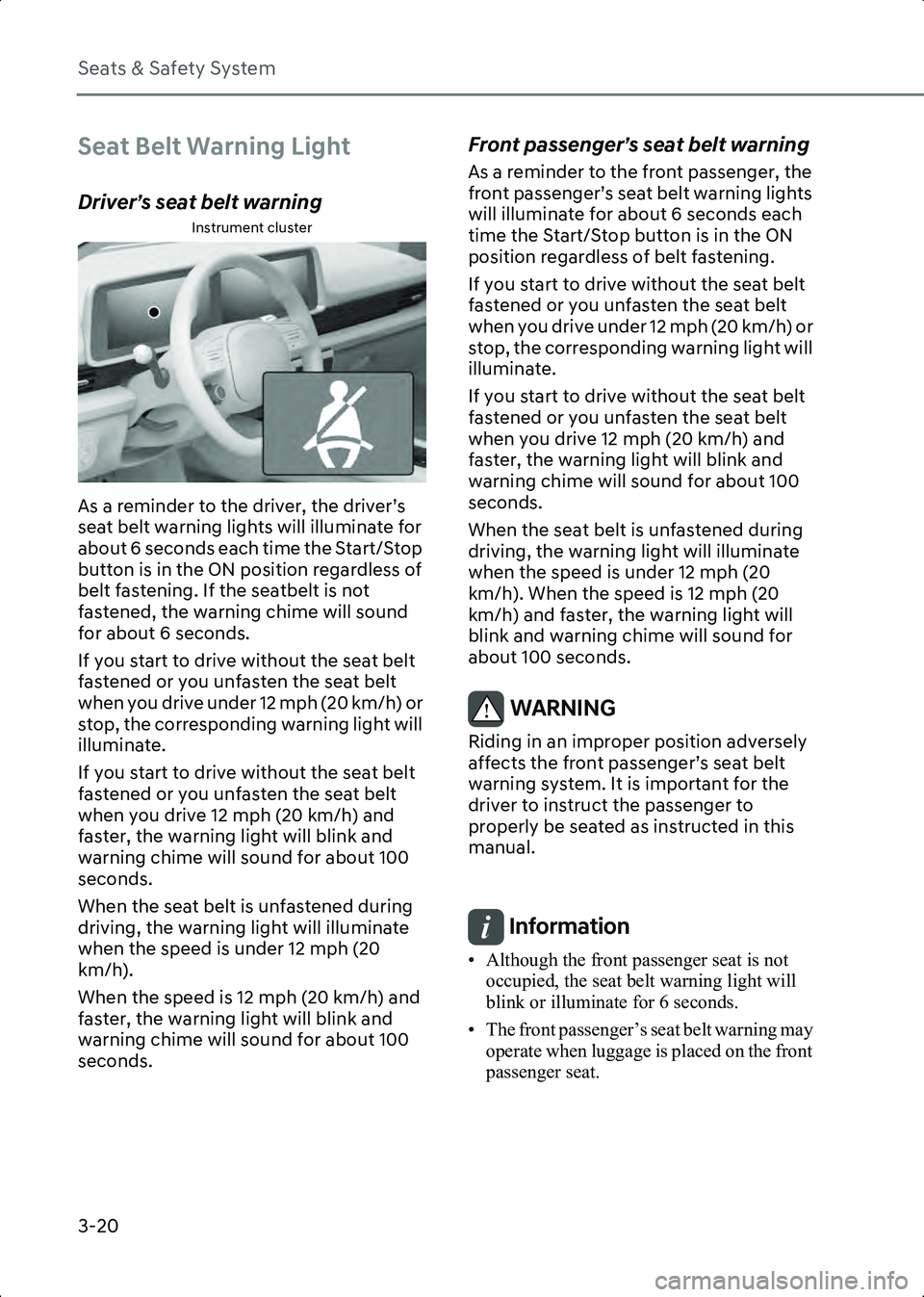
Seats & Safety System
3-20
Seat Belt Warning Light
Driver’s seat belt warning
Instrument cluster
B3001502
As a reminder to the driver, the driver’s
seat belt warning lights will illuminate for
about 6 seconds each time the Start/Stop
button is in the ON position regardless of
belt fastening. If the seatbelt is not
fastened, the warning chime will sound
for about 6 seconds.
If you start to drive without the seat belt
fastened or you unfasten the seat belt
when you drive under 12 mph (20 km/h) or
stop, the corresponding warning light will
illuminate.
If you start to drive without the seat belt
fastened or you unfasten the seat belt
when you drive 12 mph (20 km/h) and
faster, the warning light will blink and
warning chime will sound for about 100
seconds.
When the seat belt is unfastened during
driving, the warning light will illuminate
when the speed is under 12 mph (20
km/h).
When the speed is 12 mph (20 km/h) and
faster, the warning light will blink and
warning chime will sound for about 100
seconds.
Front passenger’s seat belt warning
As a reminder to the front passenger, the
front passenger’s seat belt warning lights
will illuminate for about 6 seconds each
time the Start/Stop button is in the ON
position regardless of belt fastening.
If you start to drive without the seat belt
fastened or you unfasten the seat belt
when you drive under 12 mph (20 km/h) or
stop, the corresponding warning light will
illuminate.
If you start to drive without the seat belt
fastened or you unfasten the seat belt
when you drive 12 mph (20 km/h) and
faster, the warning light will blink and
warning chime will sound for about 100
seconds.
When the seat belt is unfastened during
driving, the warning light will illuminate
when the speed is under 12 mph (20
km/h). When the speed is 12 mph (20
km/h) and faster, the warning light will
blink and warning chime will sound for
about 100 seconds.
WARNING Riding in an improper position adversely
affects the front passenger’s seat belt
warning system. It is important for the
driver to instruct the passenger to
properly be seated as instructed in this
manual.
Information • Although the front passenger seat is not occupied, the seat belt warning light will
blink or illuminate for 6 seconds.
• The front passenger’s seat belt warning may operate when luggage is placed on the front
passenger seat.
Hyundai_CE_en_US.book Page 20
Page 115 of 582
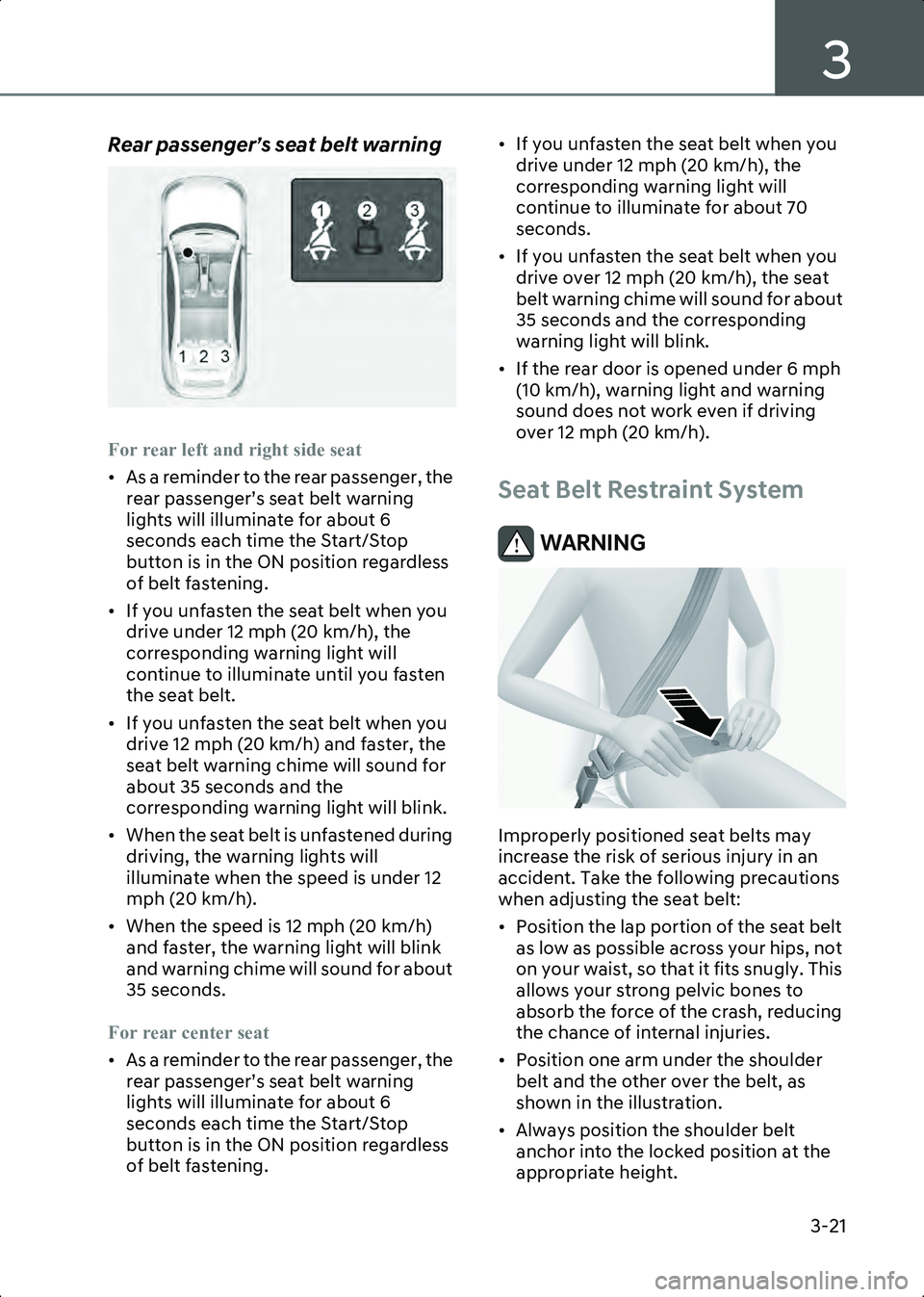
3
3-21
Rear passenger’s seat belt warning
B3001503
For rear left and right side seat
• As a reminder to the rear passenger, the rear passenger’s seat belt warning
lights will illuminate for about 6
seconds each time the Start/Stop
button is in the ON position regardless
of belt fastening.
• If you unfasten the seat belt when you drive under 12 mph (20 km/h), the
corresponding warning light will
continue to illuminate until you fasten
the seat belt.
• If you unfasten the seat belt when you drive 12 mph (20 km/h) and faster, the
seat belt warning chime will sound for
about 35 seconds and the
corresponding warning light will blink.
• When the seat belt is unfastened during driving, the warning lights will
illuminate when the speed is under 12
mph (20 km/h).
• When the speed is 12 mph (20 km/h) and faster, the warning light will blink
and warning chime will sound for about
35 seconds.
For rear center seat
• As a reminder to the rear passenger, the rear passenger’s seat belt warning
lights will illuminate for about 6
seconds each time the Start/Stop
button is in the ON position regardless
of belt fastening. • If you unfasten the seat belt when you
drive under 12 mph (20 km/h), the
corresponding warning light will
continue to illuminate for about 70
seconds.
• If you unfasten the seat belt when you drive over 12 mph (20 km/h), the seat
belt warning chime will sound for about
35 seconds and the corresponding
warning light will blink.
• If the rear door is opened under 6 mph (10 km/h), warning light and warning
sound does not work even if driving
over 12 mph (20 km/h).
Seat Belt Restraint System
WARNING
B3001505
Improperly positioned seat belts may
increase the risk of serious injury in an
accident. Take the following precautions
when adjusting the seat belt:
• Position the lap portion of the seat belt as low as possible across your hips, not
on your waist, so that it fits snugly. This
allows your strong pelvic bones to
absorb the force of the crash, reducing
the chance of internal injuries.
• Position one arm under the shoulder belt and the other over the belt, as
shown in the illustration.
• Always position the shoulder belt anchor into the locked position at the
appropriate height.
Hyundai_CE_en_US.book Page 21
Page 123 of 582

3
3-29
or by a LATCH system in the rear seats of
the vehicle.
Child Restraint System (CRS)
Infants and younger children must be
restrained in an appropriate
rearward-facing or forward-facing CRS
that has first been properly secured to the
seat of the vehicle. Read and comply with
the instructions for installation and use
provided by the manufacturer of the Child
Restraint System.
WARNING An improperly secured child restraint can
increase the risk of SERIOUS INJURY or
DEATH in an accident. Always take the
following precautions when using a Child
Restraint System:
• NEVER install a child or infant restraint in the front passenger's seat.
• Always properly secure the child restraint to a rear seat of the vehicle.
• Always follow the child restraint system manufacturer's instructions for
installation and use.
• Always properly restrain your child in the child restraint.
• If the vehicle head restraint prevents proper installation of a child seat (as
described in the child restraint system
manual), the head restraint of the
respective seating position shall be
readjusted or entirely removed.
• Do not use an infant carrier or a child safety seat that "hooks" over a
seatback, it may not provide adequate
protection in an accident.
• After an accident, have an authorized HYUNDAI dealer check the child
restraint system, seat belts, tether
anchors and lower anchors.
Selecting a Child Restraint
System (CRS)
When selecting a Child Restraint System
for your child, always:
• Make sure the Child Restraint System has a label certifying that it meets
applicable Federal Motor Vehicle
Safety Standards (FMVSS 213).
• Select a Child Restraint System based on your child’s height and weight. The
required label or the instructions for use
typically provide this information.
• Select a Child Restraint System that fits the vehicle seating position where it will
be used.
• Read and comply with the warnings and instructions for installation and use
provided with the Child Restraint
System.
Child Restraint System types
There are three main types of Child
Restraint Systems: rearward-facing,
forward-facing and booster Child
Restraint Systems.
They are classified according to the
child’s age, height and weight.
Rearward-facing Child Restraint System
B3002201
A rearward-facing Child Restraint System
provides restraint with the seating
surface against the back of the child. The
harness system holds the child in place,
and in an accident, acts to keep the child
positioned in the Child Restraint Systems
Hyundai_CE_en_US.book Page 29
Page 125 of 582
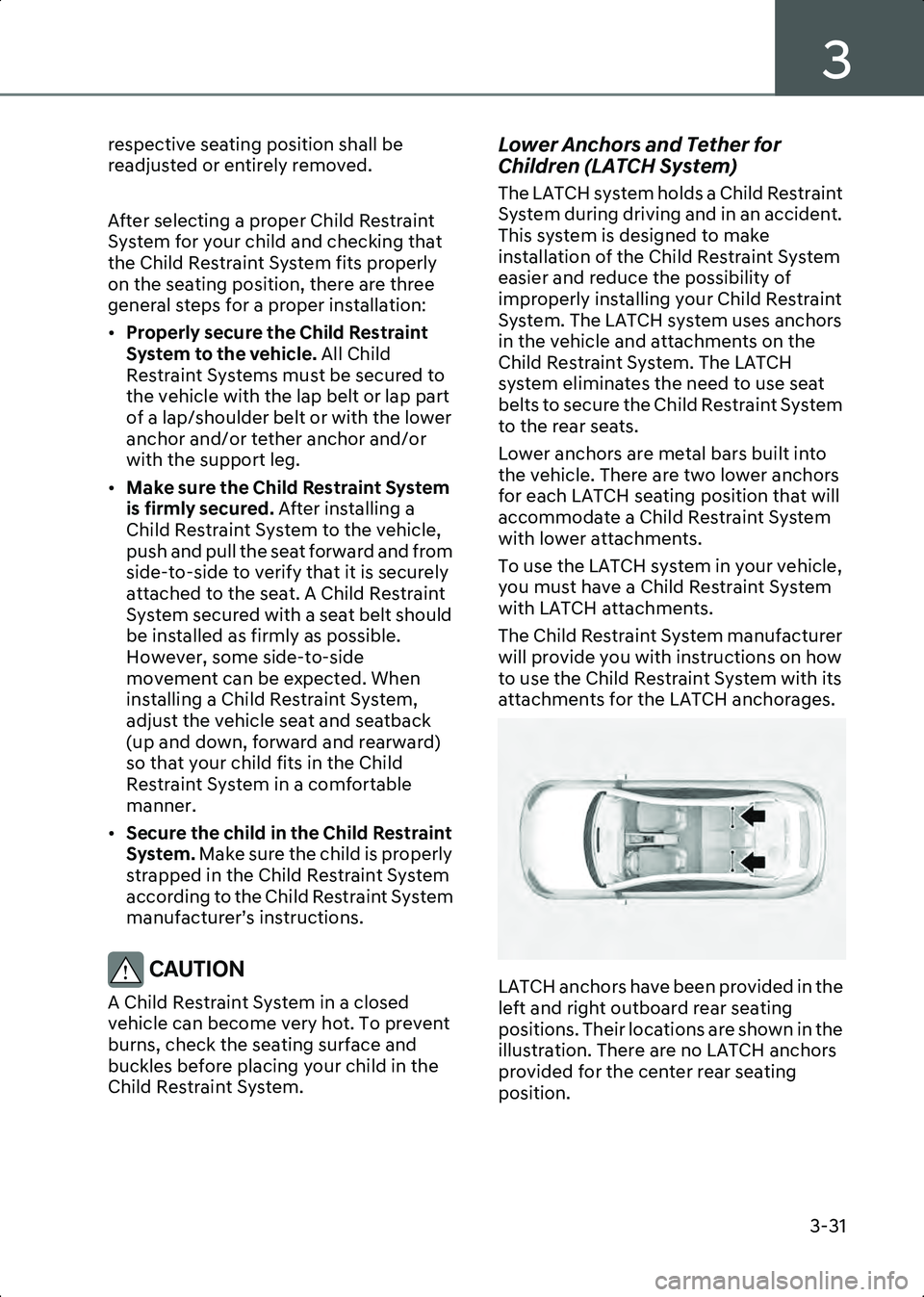
3
3-31
respective seating position shall be
readjusted or entirely removed.
After selecting a proper Child Restraint
System for your child and checking that
the Child Restraint System fits properly
on the seating position, there are three
general steps for a proper installation:
•Properly secure the Child Restraint
System to the vehicle. All Child
Restraint Systems must be secured to
the vehicle with the lap belt or lap part
of a lap/shoulder belt or with the lower
anchor and/or tether anchor and/or
with the support leg.
• Make sure the Child Restraint System
is firmly secured. After installing a
Child Restraint System to the vehicle,
push and pull the seat forward and from
side-to-side to verify that it is securely
attached to the seat. A Child Restraint
System secured with a seat belt should
be installed as firmly as possible.
However, some side-to-side
movement can be expected. When
installing a Child Restraint System,
adjust the vehicle seat and seatback
(up and down, forward and rearward)
so that your child fits in the Child
Restraint System in a comfortable
manner.
• Secure the child in the Child Restraint
System. Make sure the child is properly
strapped in the Child Restraint System
according to the Child Restraint System
manufacturer’s instructions.
CAUTION A Child Restraint System in a closed
vehicle can become very hot. To prevent
burns, check the seating surface and
buckles before placing your child in the
Child Restraint System.
Lower Anchors and Tether for
Children (LATCH System)
The LATCH system holds a Child Restraint
System during driving and in an accident.
This system is designed to make
installation of the Child Restraint System
easier and reduce the possibility of
improperly installing your Child Restraint
System. The LATCH system uses anchors
in the vehicle and attachments on the
Child Restraint System. The LATCH
system eliminates the need to use seat
belts to secure the Child Restraint System
to the rear seats.
Lower anchors are metal bars built into
the vehicle. There are two lower anchors
for each LATCH seating position that will
accommodate a Child Restraint System
with lower attachments.
To use the LATCH system in your vehicle,
you must have a Child Restraint System
with LATCH attachments.
The Child Restraint System manufacturer
will provide you with instructions on how
to use the Child Restraint System with its
attachments for the LATCH anchorages.
B3002210
LATCH anchors have been provided in the
left and right outboard rear seating
positions. Their locations are shown in the
illustration. There are no LATCH anchors
provided for the center rear seating
position.
Hyundai_CE_en_US.book Page 31
Page 133 of 582
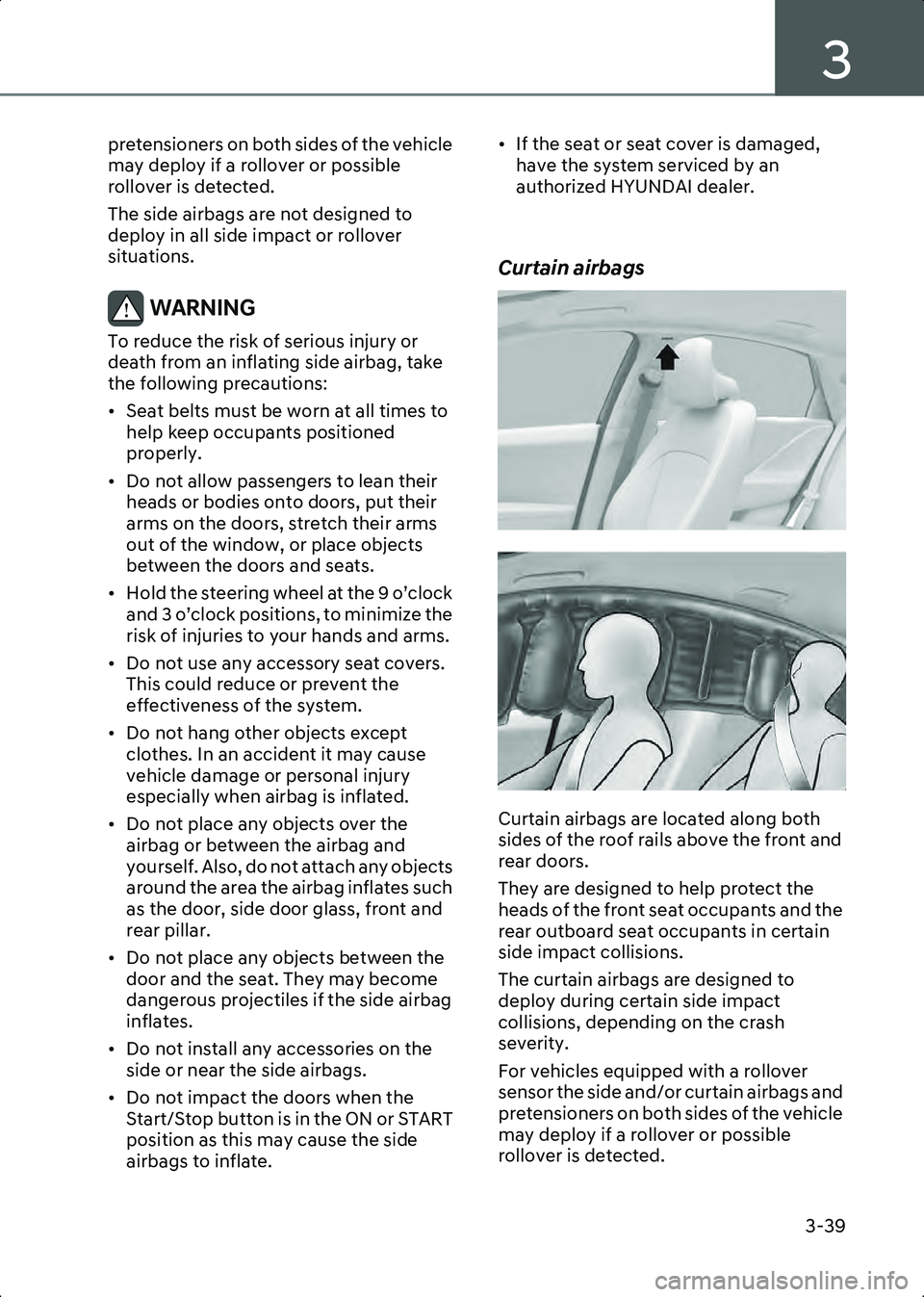
3
3-39
pretensioners on both sides of the vehicle
may deploy if a rollover or possible
rollover is detected.
The side airbags are not designed to
deploy in all side impact or rollover
situations.
WARNING To reduce the risk of serious injury or
death from an inflating side airbag, take
the following precautions:
• Seat belts must be worn at all times to help keep occupants positioned
properly.
• Do not allow passengers to lean their heads or bodies onto doors, put their
arms on the doors, stretch their arms
out of the window, or place objects
between the doors and seats.
• Hold the steering wheel at the 9 o’clock and 3 o’clock positions, to minimize the
risk of injuries to your hands and arms.
• Do not use any accessory seat covers. This could reduce or prevent the
effectiveness of the system.
• Do not hang other objects except clothes. In an accident it may cause
vehicle damage or personal injury
especially when airbag is inflated.
• Do not place any objects over the airbag or between the airbag and
yourself. Also, do not attach any objects
around the area the airbag inflates such
as the door, side door glass, front and
rear pillar.
• Do not place any objects between the door and the seat. They may become
dangerous projectiles if the side airbag
inflates.
• Do not install any accessories on the side or near the side airbags.
• Do not impact the doors when the Start/Stop button is in the ON or START
position as this may cause the side
airbags to inflate. • If the seat or seat cover is damaged,
have the system serviced by an
authorized HYUNDAI dealer.
Curtain airbags
B3003301
B3003302
Curtain airbags are located along both
sides of the roof rails above the front and
rear doors.
They are designed to help protect the
heads of the front seat occupants and the
rear outboard seat occupants in certain
side impact collisions.
The curtain airbags are designed to
deploy during certain side impact
collisions, depending on the crash
severity.
For vehicles equipped with a rollover
sensor the side and/or curtain airbags and
pretensioners on both sides of the vehicle
may deploy if a rollover or possible
rollover is detected.
Hyundai_CE_en_US.book Page 39
Page 134 of 582
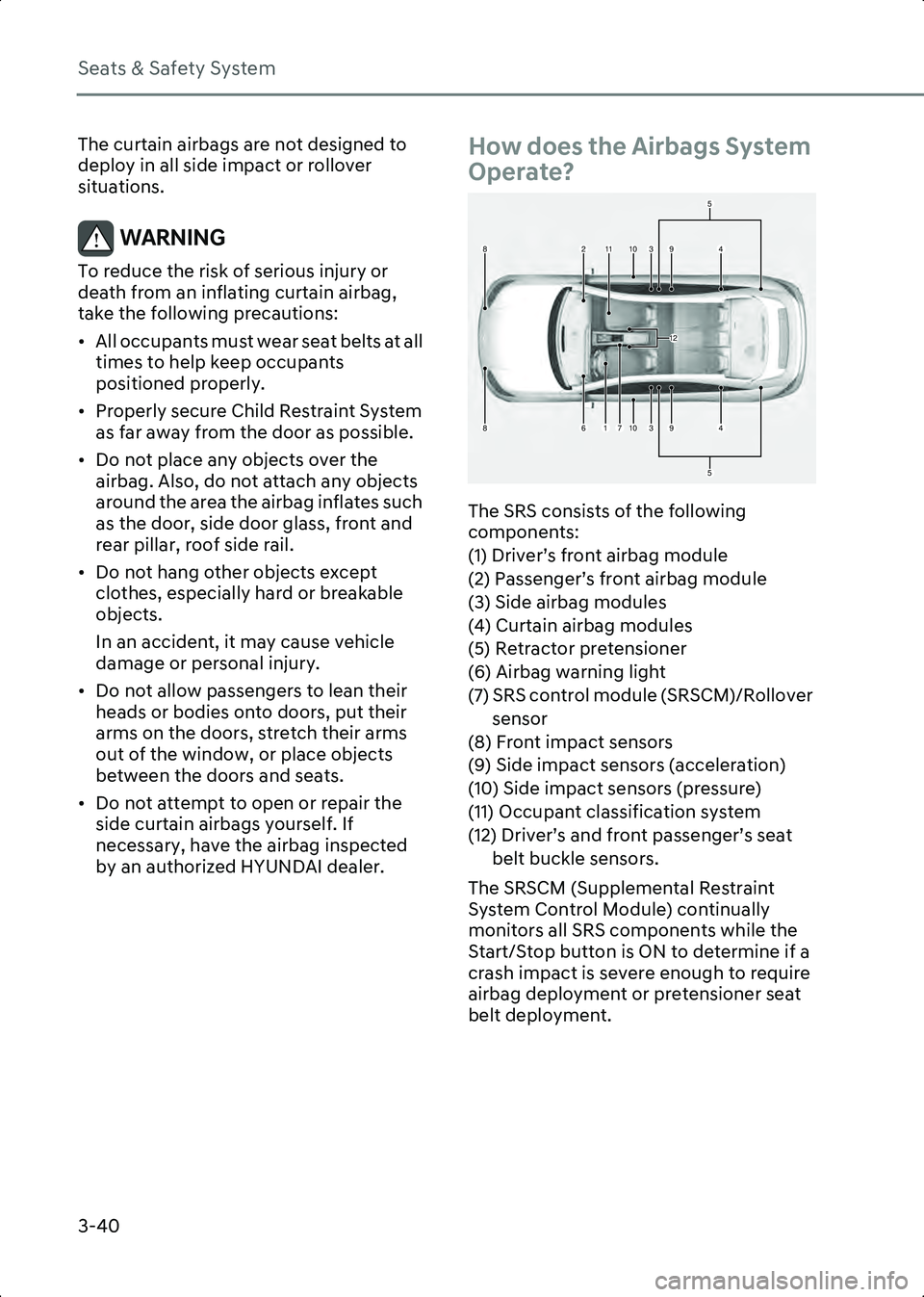
Seats & Safety System
3-40
The curtain airbags are not designed to
deploy in all side impact or rollover
situations.
WARNING To reduce the risk of serious injury or
death from an inflating curtain airbag,
take the following precautions:
• All occupants must wear seat belts at all times to help keep occupants
positioned properly.
• Properly secure Child Restraint System as far away from the door as possible.
• Do not place any objects over the airbag. Also, do not attach any objects
around the area the airbag inflates such
as the door, side door glass, front and
rear pillar, roof side rail.
• Do not hang other objects except clothes, especially hard or breakable
objects.
In an accident, it may cause vehicle
damage or personal injury.
• Do not allow passengers to lean their heads or bodies onto doors, put their
arms on the doors, stretch their arms
out of the window, or place objects
between the doors and seats.
• Do not attempt to open or repair the side curtain airbags yourself. If
necessary, have the airbag inspected
by an authorized HYUNDAI dealer.
How does the Airbags System
Operate?
A3002401
The SRS consists of the following
components:
(1) Driver’s front airbag module
(2) Passenger’s front airbag module
(3) Side airbag modules
(4) Curtain airbag modules
(5) Retractor pretensioner
(6) Airbag warning light
(7) SRS control module (SRSCM)/Rollover sensor
(8) Front impact sensors
(9) Side impact sensors (acceleration)
(10) Side impact sensors (pressure)
(11) Occupant classification system
(12) Driver’s and front passenger’s seat belt buckle sensors.
The SRSCM (Supplemental Restraint
System Control Module) continually
monitors all SRS components while the
Start/Stop button is ON to determine if a
crash impact is severe enough to require
airbag deployment or pretensioner seat
belt deployment.
4
5
5
11
1
23
37
8
86
9
49
10
10
12
Hyundai_CE_en_US.book Page 40
Page 135 of 582

3
3-41
SRS warning light
B3002501
The SRS (Supplemental Restraint System)
airbag warning light on the instrument
cluster the airbag symbol depicted in the
illustration. The system checks the airbag
electrical system for malfunctions. The
light indicates that there is a potential
problem with your airbag system, which
could include your side and/or curtain
airbags used for rollover protection.
WARNING If your SRS malfunctions, the airbag may
not inflate properly during an accident
increasing the risk of serious injury or
death.
If any of the following conditions occur,
your SRS is malfunctioning:
• The light does not turn on for about 3-6 seconds when the Start/Stop button is
in the ON position.
• The light stays on after illuminating for about three to 6 seconds.
• The light comes on while the vehicle is in motion.
• The light blinks when the (ready indicator) is displayed on the
instrument cluster.
Have an authorized HYUNDAI dealer
inspect the SRS as soon as possible if any
of these conditions occur.
During a moderate to severe frontal
collision, sensors will detect the vehicle’s
rapid deceleration. If the rate of
deceleration is high enough, the control
unit will inflate the front airbags, at the
time and with the force needed.
The front airbags help protect the driver
and front passenger by responding to
frontal impacts in which seat belts alone
cannot provide adequate restraint. When
needed, the side airbags help provide
protection in the event of a side impact or
rollover by supporting the side upper
body area.
• Airbags are activated (able to inflate if
necessary) only when the Start/Stop
button is in the ON or START position,
and it can be activated within about 3
minutes after the vehicle is turned off.
• Airbags inflate in the event of certain frontal or side collisions to help protect
the occupants from serious physical
injury.
• Generally, airbags are designed to inflate based upon the severity of a
collision, its direction, or etc. These two
factors determine whether the sensors
produce an electronic
deployment/inflation signal.
• The front airbags will completely inflate and deflate in an instant. It is virtually
impossible for you to see the airbags
inflate during an accident. It is much
more likely that you will simply see the
deflated airbags hanging out of their
storage compartments after the
collision.
• In addition to inflating in serious side collisions, vehicles equipped with a
rollover sensor, side and/or curtain
airbags will inflate if the sensing system
detects a rollover.
When a rollover is detected, curtain
airbags will remain inflated longer to
help provide protection from ejection,
especially when used in conjunction
with the seat belts. (if equipped with a
rollover sensor)
Hyundai_CE_en_US.book Page 41
Page 136 of 582

Seats & Safety System
3-42
• To help provide protection, the airbags must inflate rapidly. The speed of
airbag inflation is a consequence of
extremely short time in which to inflate
the airbag between the occupant and
the vehicle structures before the
occupant impacts those structures.
This speed of inflation reduces the risk
of serious or life-threatening injuries
and is thus a necessary part of airbag
design.
However, the rapid airbag inflation can
also cause injuries which can include
facial abrasions, bruises and broken
bones because the inflation speed also
causes the airbags to expand with a
great deal of force.
• There are even circumstances under which contact with the airbag can
cause fatal injuries, especially if the
occupant is positioned excessively
close to the airbag.
You can take steps to reduce the risk of
being injured by an inflating airbag. The
greatest risk is sitting too close to the
airbag. An airbag needs about 10 in. (25
cm) of space to inflate. NHTSA
recommends that drivers allow at least 10
in. (25 cm) between the center of the
steering wheel and the chest.
WARNING To reduce the risk of serious injury or
death from an inflating airbag, take the
following precautions:
• NEVER place a child restraint in the front passenger seat.
Always properly restrain children under
age 13 in the rear seats of the vehicle.
• Adjust the front passenger’s and driver's seats as far to the rear as
possible while allowing you to maintain
full control of the vehicle.
• Hold the steering wheel with hands at the 9 o'clock and 3 o'clock positions. • Never place anything or anyone
between the airbag and the seat
occupant.
• Do not allow the front passenger to place their feet or legs on the
dashboard.
Driver’s front airbag (1)
OLMB033054
When the SRSCM detects a sufficiently
severe impact to the front of the vehicle,
it will automatically deploy the front
airbags.
Driver’s front airbag (2)
OLMB033055
Upon deployment, tear seam molded
directly into the pad cover will separate
under pressure from the expansion of the
airbags. Further opening of the covers
allows full inflation of the airbags.
A fully inflated airbag, in combination
with a properly worn seat belt, slows the
driver’s or the front passenger’s forward
Hyundai_CE_en_US.book Page 42